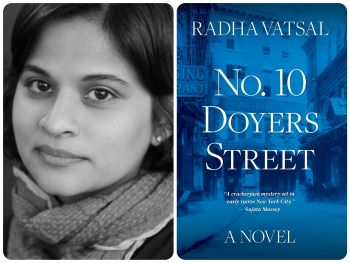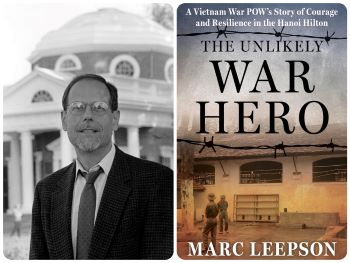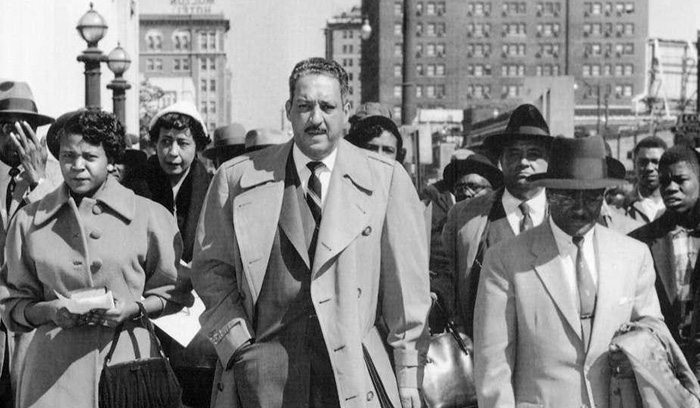The novelist talks mysteries, 1900s Chinatown, and never letting rejection get you down.

In No. 10 Doyers Street, author Radha Vatsal again dives into historical fiction. As in her Kitty Weeks Mystery series, Vatsal’s new novel is set in the early 1900s and follows a reporter. This time, our narrator, Archana Morley, investigates top players in New York’s Chinatown, including the rival gang leaders Mock Duck (of the Hip Sing Songs) and Tom Lee (of the On Leong Tongs). Born and raised in Mumbai and now living in Manhattan, Vatsal attended Duke University to study film history and Victorian literature. In all her books, she brings to life — via research and imagination — little-known stories from the beginning of the 20th century.
You’ve said that you focus on the early 1900s because it was an important period in women’s history. Which events from that time most resonate with you?
The early 1900s were a fascinating time — the United States was not yet a superpower and was still figuring out what kind of country it wanted to be. New York City was shifting away from being a scrappy town with makeshift rules and, particularly downtown, a hodge-podge jumble of streets. Also, it was only in 1898 that New York dramatically increased in size and went from being comprised of only Manhattan and part of the Bronx to also include Brooklyn, western Queens, and Staten Island. So that was a huge shift.
Women were out and about making strides in professions like journalism and medicine, [and] immigrants from all over the world — not just Europe, but Asia, too — were pouring in. This is the milieu in which No. 10 Doyers Street takes place. The novel tells the story of the infamous Chinatown gangster Mock Duck and his young daughter through the perspective of a woman journalist from India. It tells the story of how the city wanted to tame Mock and get rid of Doyers Street and Chinatown entirely. The authorities wanted no more crooked streets like Doyers and no more non-European ethnic neighborhoods like Chinatown.
The novel centers on the real-life case of Chinatown gangster Mock Duck. How did you decide which details could be fictionalized and which should remain true to the facts?
Mock Duck was a legend even in his 20s. People were terrified of him and attributed superhuman characteristics to him. As Archana Morley, the narrator of No. 10 Doyers Street, observes:
“His dead, expressionless eyes gazed from the backs of playing cards and souvenir matchboxes. Street urchins sang ditties in his honor. They said that he could hear a pin drop, see around corners, and that his rhinoceros-thick skin protected him from injury.”
But Mock Duck was also a loving father and a cunning strategist who was able to use the American legal system to his advantage. So the challenge I had was sifting through all the contradictory accounts and the hyperbole and humanizing him. Most of what happens in the novel is true to the facts or guesswork that fills in the blanks between the facts. Sometimes, when the truth is unknown (e.g., Mock Duck’s childhood), Archana hears different stories about it and then she and the reader have to make up their minds about what to believe. At times, I compress the timeline to speed up the action, but nothing in the novel contradicts or goes against what we know happened. I quote newspaper sources — even when they contradict each other — pretty much word for word. That’s very important to me because, in this case, truth is stranger than fiction.
All of your novels thus far have been told through the eyes of a reporter. What appeals to you about casting a journalist in the lead role?
Reporters possess all the characteristics of a detective while also having to constantly come up with something to write — in that way, they’re a perfect surrogate for a mystery writer. They’re constantly trying to figure things out and rushing from one deadline to another. That creates its own narrative urgency. Also, all my novels interweave a mystery with real events — that is to say, with other things that are happening in the world/city at the time. A reporter is perfectly positioned to know about these things and care about them.
In No.10 Doyers Street, the big event that’s happening is the murder trial of the millionaire Harry Thaw. That was like the O.J. Simpson trial of the 1990s. It consumed all the oxygen — no one was talking about anything else. So, Archana has no choice but to cover that trial, but at the same time, she’s trying to get to the bottom of the story that she thinks is really important — the story of Mock Duck and his daughter. And it’s the tension between the two cases that I find fascinating. Because, of course, the Harry Thaw case is the one that got all the attention. And Mock Duck’s story is all but forgotten.
Your Kitty Weeks mysteries feature a recurring heroine. Do you envision No. 10 Doyers Street’s Archana Morley getting her own series, too?
Archana is a very different character from Kitty. She’s in her 30s, an immigrant from India, she’s married to an American, she’s been working in the newspaper world for several years and has experienced more hardships. I hadn’t envisioned her as a recurring heroine, but you never know...
Looking back, what advice do you wish you’d been given when you were first starting out as a writer?
The best advice I could have been given is to write no matter what happens. Writing involves more rejection than success, and the best part of the process is the act of writing itself. Those moments when all the characters are alive in your mind and you’re waiting to see what happens…and taking it all down like a scribe. Those are perfect. Everything else — like finding an agent, getting published, how well your book does — is much less in your control. There can be a lot of heartbreak and frustration in that. But no one can ever stop you from writing.
[Photo by Juliette Conroy.]
Christina Hawkins, a senior English major at UMBC, recently completed an internship at the Independent.

